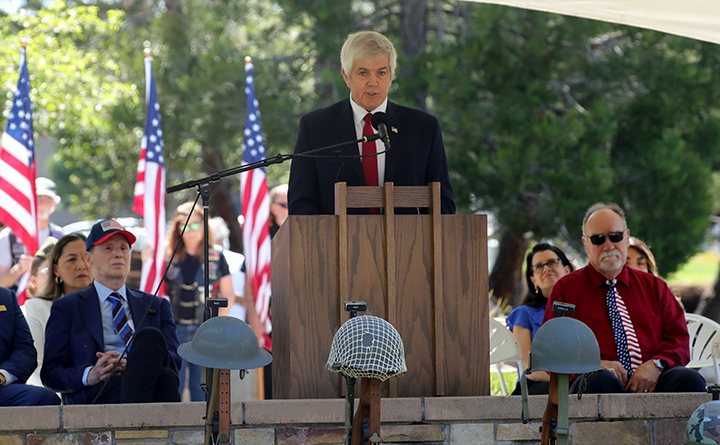East Oregonian Days Gone By for Jan. 9, 2024
Published 5:00 am Tuesday, January 9, 2024

- 1999 — Fifth grader Elizabeth Baldwin, right, inspects her squashed egg after its protective covering failed to do its job when the egg was dropped from the roof at Washington Elementary School in Pendleton. Fourth grader Jenna Richter, left, keeps track of the results as other students enjoy the fun. Principal Dick Pratt took winners of the competition to lunch at Hal's Hamburgers.
25 years ago this week — 1999
Vanda Parker went to get a drink of water in her bathroom Friday morning and noticed there was no water pressure.
“I went to the kitchen to check the water there. I looked outside and went, ‘Oh my God!’”
What she saw when she looked out the window was 1½ feet of water surrounding her house.
“The whole front yard was flooded and around the back to our shop,” Parker said. “And our dog was in her pen howling, with water up to her belly.”
Parker lives on Southeast Third Street, right where a 16-inch water main broke at about 11 a.m. She frantically thumbled through her phone book to find the number of the city water department, and then went out and waded to the street to move her car so it wouldn’t fill with water.
“It was big excitement,” Parker said. I could see a lot of water dubbing up right here,” she said, pointing to a large crater in the street in front of her house where city crews were uncovering the broken pipeline with a backhoe.
———
Pfc. Ryan Hadden’s career in the U.S. Army is a world away from close-order drill, guard duty and bivouac in the boondocks.
As of one of only 14 marksmen in his classification — carefully chosen by Uncle Sam for the Army’s Marksmanship Unit — the Pendleton serviceman’s universe is one where the government-issue M-16 rifle has been replaced by a $10,000 custom-made shotgun.
“When I got into the Army they opened up the doors and asked me to pick two shot-guns,” Hadden said during a recent holiday visit to Pendleton.
“So, I have a new Perazzi MX-8 Special that I use for a backup and an overstock MX-8 that I shoot with,” he said. The Italian-made guns are coveted by world-class sharpshooters.
Hadden’s shotgun team is part of a 100-member unit that also included experts in pistol and rifle shooting. His daily routine on the Olympic Shooting Range at Ft. Benning, near Columbus, Ga., consists of training and practice for international trap competitions against all comers, including fellow team members.
———
There are still no answers regarding the cause of a recent natural gas pipeline explosion on the Umatilla Indian Reservation.
Representatives from William’ Northwest pipeline crossing the reservation, and Cascade Natural Gas Corp. traveled to Mission late last week to meet with tribal leaders.
“At that point they didn’t have their investigation done, so they couldn’t give us any reason why it happened,” said tribal spokeswoman Debra Croswell.
That is still the case, according to Jennifer Pierce, a representative of Williams’ based in Salt Lake City.
But the meeting “went well, as well as could be expected,” Pierce said.
The meeting allowed all sides to communicate concerns about the explosion and the coordination efforts, Pierce explained. “It was something both groups wanted to do, to review the incident.”
During the meeting, tribal representatives questioned the Williams’ and Cascade representatives about the safety of the pipeline and the cause of the explosion, which sent flames shooting into the sky for several hours.
50 years ago this week —1974
Gov. Tom McCall’s gasoline plan is unneeded in Pendleton, gas station operators in Pendleton said today. “It sounds like it will work fine for Portland,” said one, “But we’ve been taking care of our own (in Pendleton) pretty good” without any allocation system. “What we need is more gasoline.”
Guerney Walters of Walters Chevron Service thinks “there might be a lot of confusion” if the plan were tried in Pendleton.
Pendleton dealers are not members of the state association and are not committed to follow the plan approved by the association.
Pendleton dealers listed some of the problems they foresaw:
Plumbers, unless they fall into the category of commercial vehicles which may purchase gas any day, will be hard pressed during extreme cold weather when they are making many calls.
“What is the dealer to do,” wondered one, “If he fills up a customer’s tank and finds the motorist has more than half a tank already?” Under McCall’s plan, motorists with more than half a tank would not be allowed to buy gasoline.
———
About 2,000 homes and businesses in Milton-Freewater and another 600 homes on Weston Mountain were without power Thursday when rifle fire severed a power line.
Harold Cantrell, area manager for Bonneville Power Administration, Walla Walla, said BPA’s 69,000 volt transmission line was sevred near Barrett Station, about four miles west of Milton-Freewater.
He said Milton-Freewater was without power for about 30 minutes until the power could be switched to an alternate source.
A Umatilla Electric Cooperative line which tapped into the severed line, served the Weston Mountain-Tollgate area. There was no alternate power source for that area, according to Cantrell. It was without power until the line could be repaired.
A UEC spokesman said power was out from about 3:10 p.m. to 7:30 p.m. on Weston Mountain. About 600 meters, including those at seasonal cabins, were affected, UEC said.
———
St. Joseph’s Academy in Pendleton, opened in 1887, will close at the end of the school year, and its 119 pupils will be absorbed into the Pendleton public school system.
The Most Rev. Thomas J. Connolly, Baker, bishop of the Baker diocese, and Father James O’Conner, Pendleton, pastor of St. Mary’s Parish, made the announcement in letters to parents of St. Joseph’s pupils.
The churchmen said several reasons lie behind the decision to close the school – “declining enrollment, the unavailability of additional Sisters to teach, which would necessitate hiring three additional lay teachers and the inevitable large increase in the cost of operation, and the quality of education provided by the Pendleton public schools.”
They said an extensive investigation as to the feasibility of continuing to operate St. Joseph’s was conducted in recent weeks. Meetings were held with the Provincial Superior of the Sisters of St. Francis, the parish school board, the parish council, the parents of the pupils, the school staff and other consultants.
St. Joseph’s offered education through high school until 1962, through nine grades until four years ago, and six grades since then.
100 years ago this week — 1924
E. L. Potter, head of the department of animal husbandry at O. A. C., and W. L. Thompson, vice president of the First National Bank of Portland were speakers at the Rotary club today. Mr. Potter talked of the livestock situation in the state and gave particular emphasis to the possibility of using that part of the government land outside the forest reserves. This includes 25 per cent of the area of Oregon and is mostly in the southwestern part of the state. The land is low grade range land and at present is of little use because it is unregulated. Mr. Potter estimates that through some practical plan that would provide for the control of the land the state’s wealth could be increased from $20,000,000 to $50,000,000. He advocated no particular plan but declared that most any regulatory plan would improve upon the present state of affairs.
———
A discussion of the cost of producing wheat in relation to the rentals that are now being paid for reservation land belonging to Indians will be held next Tuesday afternoon in the rooms of the Pendleton Commercial association in a meeting of wheat growers that has been called by the executive committee of the Umatilla county farm bureau.
An investigation of the subject shows that the rentals of land have followed the price of wheat, according to Fred Bennion. The peak price for the use of reservation land was reached in 1920 when the best land rented for as much as $21 an acre. Some leases that year were made for four years, and in some cases farmers will have to pay rentals on the 1924 crop of $21 an acre. Such a rental will cause the grower to take a heavy loss, the county agent pointed out.
Lease prices began to drop in 1921 and in the fall of 1923 the maximum rentals were about $13 an acre, but even at this figure wheat farmers are reported to be taking losses on their operations.
———
Payment for the entire cost of construction of the bridge across McKay creek, together with the cost of the approaches, has been borne by the state. Action to this effect was taken at the January meeting of the state highway commission at Portland last week, according to I. M. Schannep, county judge, who with Commissioners Bean and Hales was in attendance at the session.
The cost of the bridge and approaches was $27,500, and the arrangement entered into before the work was done was to the effect that the state would pay $14,500 and Umatilla county should pay $13,000. By the action of the commission the county is reliced of paying anything on the bridge.
That part of the Oregon-Washington highway between the McKay bridge and Pendleton will be resurfaced during the coming summer. Bids for the work are to be let at the March meeting of the commission. This stretch of road has been rough for several years, and has given trouble in particular lately by reason of the increased traffic it has had to bear by the reason of the construction of the dam by the government on McKay creek.









